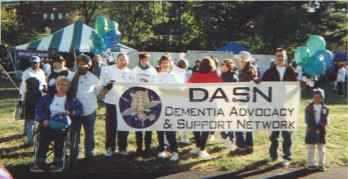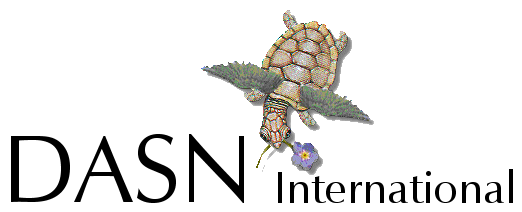DASN's History

The DASN group was formally opened on the Yahoo website 8/11/2000. This was originally done by Laura Smith as she was the only member at that time with the Internet knowledge to do so. The DASN group was an off shoot of the Coping With Personal Memory Loss (CWPML) group, an active advocacy group for people with early stage dementia and their care partners. In the first month the group totaled 19 people and by the first annual meeting, the number had increased to 21.
The first official organizational meeting of DASN was held October6, 2000, during the Heartland Memory Walk in Kansas City, Kansas. Those who attended included Shannon Ocsody, Laura Smith, Phil Hardt, Lynn Jackson, and Morris Friedell. The general DASN support network was polled prior to the meeting as to whether they would like to participate as directors -- many declined for various reasons, however, those who showed interest were appointed positions by the group at hand as to where they believed they might be of most benefit to the group (even though they were not in attendance at the meeting). This was the beginning. We were a small network of like-minded individuals all working to make our dream idea into a reality. We were not so much concerned with quorums or policy as we were with our commonality of views and our concern of making our idea a reality. We felt like getting DASN off the ground and moving forward was of utmost importance. Again, not because anyone nominated her to do it, but rather because she offered, Laura Smith chose to take on the task of making DASN a nonprofit organization to comply with the state law of Montana, where Laura resided. DASN had already grown into a global community, where the location or status of registration was of little importance, only that it was done.
By the end of the year 2000 the DASN network had grown from 21 to 40. Because Alice Young was going to Montana for a visit, it was discussed in chat that we would all like to meet our cyber friends in person and from there, after the most gracious invitation from Laura Smith, it snowballed into our second Annual General Meeting, only nine short months later. This was discussed in chat and on the message boards, everyone who could make it was urged to do so, those that could not were prompted to let it be known if they cared to be part of the directors. By now the network had doubled to 82 and was still not formalized because of the size.
This was to be the foundation of the official DASN International where we agreed to form a new DASN International community and website. The original by-laws were reviewed, amended and adopted. The DASN(now DASN International) ADI proposal was reviewed and approved. Directors present agreed that there would be an executive committee comprised of (and elected at the meeting):
President - Phil Hardt;
Vice-president - Lynn Jackson;
Treasurer - Morris Friedell;
Co-Secretary's - Carole Mulliken and Jan Phillips
It was agreed that the executive should serve from the date of election until the next annual meeting, when all positions fall vacant.
The following Directors were appointed to be responsible for DASN International committees:
Website (www.DASNInternational.org), Phil Hardt;
Chatroom , Mary Lockhart, Alice Young, and Laura Smith;
E-mail (Yahoo, Mary Lockhart; Carole Mulliken;
Publications and Media Relations, Jan Phillips;
Policy and Strategy, Morris Friedell and Christine Bryden;
Next AGM, Jeanne Lee;
Funding, Candy Harrison;
Correspondence, Carole Mulliken and Jan Phillips.
Although not everyone belonging to the network group was able to attend, a total of 13 people volunteered and were elected as directors.
It was further agreed that:
- A quorum at meeting shall be 7 directors, with a majority being 4 of the 7 present;
- Business can be conducted by email with confirmation of the e-mail being opened being requested. Voting responses required within 7 days. In the event of no response, that person's vote will be counted as in favor of the measure being voted upon;
- Directors may assign their proxy to another Director;
- A 2/3 majority of Directors would be required to suspend a Director from their position due to incapacity;
- There would be no censorship in chat or e-mail. However, any inappropriate behavior will be dealt with by the board on a case by case basis, dealing directly with the individual concerned.
As of this writing, November 20, 2001, our network group now totals 143 people with dementia and our loyal allies, an increase of 61 people just in the past 4 months.
Our concerns are global, our intentions noble. We are a group of people who are not concerned about titles or status as individuals. Our desire is to work together for the good of other Persons with Dementia (PWiDs). We believe that through the interaction with people who are living in similar circumstances, PWiDs can enrich their own lives, as well as others.
DASN International Bylaws 2002 (in Word format)
DASN International Bylaws 2002 (in PDF format)
THE INCLUSION OF PEOPLE WITH DEMENTIA WITHIN ALZHEIMER'S DISEASE INTERNATIONAL:
A PERSONAL VIEWPOINT
Members of DASNI no doubt already know that Wednesday October 15 2003 was a remarkable day in the history of Alzheimer's Disease International (ADI). This was the day in which a person with dementia was first appointed to the Board of ADI. People with dementia around the world are now extremely well placed to have their views listened to - and acted upon globally. This bolsters the great work already being carried out by people with dementia in national and local Alzheimer associations.
I am writing this brief account of the changes that have taken place over the past two years as a tribute to Christine Bryden who has been elected to the ADI Board, to Peter Ashley whose name was put forward for nomination to the Board, and to members of DASN International. It is your commitment to advocacy and to making a difference for people with dementia generally that has brought about these far-reaching changes.
From a DASNI perspective, the most readily identifiable beginning of this pathway to an ADI appointment is probably the first DASN meeting at Montana in June 2001. The real starting date is well before this though when DASN's founders encouraged email communication between people with dementia by setting up the internet chat room.
The Montana meeting set the scene for changes in ADI by developing a strategic framework that clearly set out areas of concern for people with dementia. This Montana proposal contained a number of recommendations for how ADI and Alzheimer's Associations around the world could give greater recognition to the needs of people with dementia and their care-partners.
Immediately following the Montana gathering, a contingent of two, Christine and Paul Bryden, travelled to London and met with the ADI Director, Elizabeth Rimmer, and Chairman, Nori Graham, to present the DASN proposal. From this emerged a suggestion that people get together at the forthcoming ADI conference in New Zealand to look at ways the Alzheimer's movement might become more inclusive of people with dementia.
The October 2001 ADI conference in Christchurch, New Zealand, was an extraordinary event because of the input of people with dementia. This was the first time people with dementia attended the international conference as full participants. Twelve people came, some from as far away as Canada, United States and Australia. The contribution of these twelve turned the conference into an amazingly challenging and inspirational event - for conference delegates and the wider public. Here were people with dementia showing in such an irrefutable way that not only does life continue after diagnosis but that people with dementia have much to offer within the Alzheimer's organisation.
People with dementia participated throughout the conference, from the delivery of a standing-ovation opening address to oral presentations, running workshops and media interviews. The DASN stand was a drawcard in the exhibitors' hall. The brochures that had been produced by DASN members were in high demand and quickly became "collectors' items" for the delegates.
A group of people with dementia (all members of DASN International) and Alzheimer's Disease International (ADI) executive and staff was formed at this conference to work through strategies for Alzheimer's associations around the world to be more inclusive of people with dementia. The tasks tackled by the group were a review of the wording of the ADI Charter of Principles for the Care of People with Dementia and their Carers and the production of a factsheet on how Alzheimer's groups can better include people with dementia in their activities. The outcomes from the working group can be viewed on the ADI website - www.alz.co.uk/publications. In addition to the factsheet, there is a section on the ADI intranet that provides suggestions for member organisations on how to work more closely with people with dementia.
The ADI conference in Barcelona in October 2002 was the second milestone of change for people with dementia. At their meeting held beforehand, the Council decided to seek ways to increase the participation of people with dementia in ADI itself. A new working group was convened to give guidance back to Council on this when its members next met in October 2003. This group, again consisting of people with dementia and ADI executive and staff, communicated together by email during the subsequent months.
A major focus of the working group was looking at how people with dementia could become involved in ADI decision-making. There were a number of hurdles to be overcome with this, such as making provision for people with dementia to be appropriately supported in any tasks they took on. At that stage, Peter Ashley was the only person with dementia on the executive or board of a national Alzheimer's member association. Peter drew on his personal experience to give invaluable assistance to the working group on factors that could affect a governance role.
The final recommendation from the group was that up to two people with dementia be elected on to the executive (now known as the board) of ADI. The terms and conditions of office should be the same as for other members of the Alzheimer's board. However, special consideration is needed for financial help or other assistance that board members with dementia require to attend and participate fully in meetings. The specifics of any help will be individually worked out with incoming board members.
The working group's recommendations were included in the wider governance and membership review which was being carried out by ADI at the same time. These were approved in principle by the ADI Council at the Dominican Republic conference. Formal constitutional changes will be adopted in the ADI bylaws next year.
During the early part of this year it seemed that a person with dementia could not be elected into a governance position in 2003 because of the length of time taken for bylaw changes. This situation changed in recent months with the unexpected occurrence of two vacancies on the executive committee. Christine was nominated by her member country, Australia, and it was a great thrill to hear her name announced after the votes were counted. Part of Christine's new role will be liaising with people with dementia through their Alzheimer's associations (and through DASN International) so that she is able to represent their views on the board.
The appointment of the first person with dementia within ADI is a gigantic step forward - a step that was thought impossible only a short time ago. The credit for this turnaround goes to members of DASN International and to the other active campaigners with dementia who have worked hard to be recognised within the Alzheimer's movement. The election on October 15 is truly an occasion for everyone to celebrate.
Verna Schofield
2 December 2003
